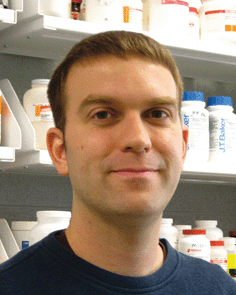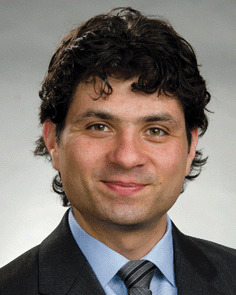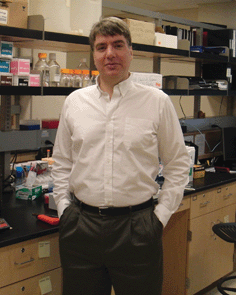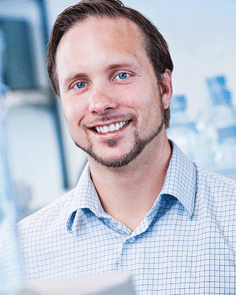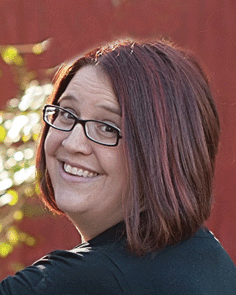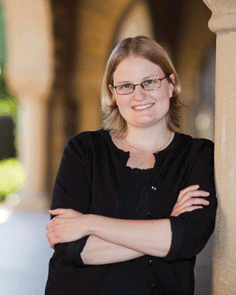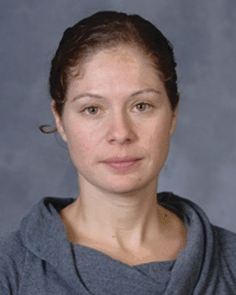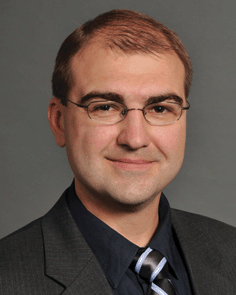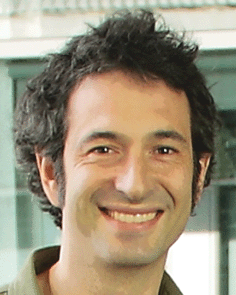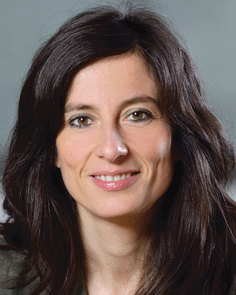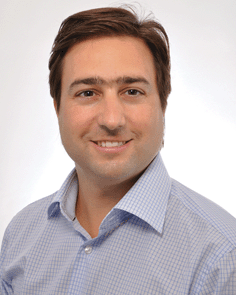DOI:
10.1039/C4MB90016B
(Profile)
Mol. BioSyst., 2014,
10, 1628-1631
Contributors to Emerging Investigators 2014
Welcome to this Molecular BioSystems themed issue, where we highlight the work of emerging investigators. This popular themed issue is the sixth in the series and we are again delighted to showcase relatively recent investigators in chemical biology, systems biology and the -omics sciences, the core areas of Molecular BioSystems. The investigators were chosen based on recommendations of the Editorial and Advisory Board and represent a diverse international community. This issue includes 12 papers (5 Articles, 2 Communications, 1 Method and 4 Reviews), ranging from the development of new chemical tools to large scale network analyses. We congratulate the emerging investigators and their teams on their achievements and wish them continued success in the future.
Ulrike Eggert, King's College London, UK.
Michael Washburn, Stowers Institute, USA.
Jeffrey E. Barrick is an Assistant Professor in the Department of Molecular Biosciences at the University of Texas at Austin. He holds a BS degree in Chemistry from the California Institute of Technology and a PhD in Molecular Biophysics and Biochemistry from Yale University. Jeff is the recipient of a HHMI Predoctoral Fellowship, an NSF Postdoctoral Research Fellowship in Biological Informatics, and an NIH Pathway to Independence Award (K99/R00). His laboratory uses experimental evolution and synthetic biology approaches to understand how the evolutionary potential of microorganisms can be engineered and to reconstruct genetic pathways leading to evolutionary innovations.
Ilya Finkelstein is an Assistant Professor in the Department of Molecular Biosciences at the University of Texas at Austin. Ilya received his BS from the University of California at Berkeley and his PhD in Chemistry from Stanford University. During his postdoctoral studies at Columbia University Medical Center, Dr Finkelstein developed a high-throughput single-molecule imaging platform to interrogate the molecular mechanisms of DNA damage repair. Currently, Dr Finkelstein's research aims to understand the mechanisms of genome maintenance and cellular aging. His interdisciplinary lab combines aspects of micro-/nano-fabrication, microscopy, and quantitative single cell biology to define the genetic and physiological determinants of cellular aging.
Simon H. Friedman was born in Chicago and raised on its mean streets. He attended public schools, taking courses in mathematics, chemistry and foundry. He received his BS in chemistry from MIT, where he did three years of research in the physics department. He was named as the inventor on multiple US and international patents for anti-cataract compounds developed during this time. His mentor and occasional sparring partner was Dr John Thomson. He earned his PhD in pharmaceutical chemistry in the highly interdisciplinary lab of George Kenyon at UCSF, publishing the first papers on a biological application of C60 fullerene, which have been cited over 800 times. Following this, he was a NIH fellow in the lab of Peter Dervan, an experience that expanded his mind in compelling and unexpected ways. Currently he is a professor at the University of Missouri, Kansas City, where he continues to work at the interface of chemistry and biology, including studies of light activated RNA interference, insulin delivery, the targeting of RNA and a series of odd projects that defy description here.
Lujian Liao received his MS degree in Computer Science in 2001 and his PhD degree in Biological Sciences/Neurobiology in 2002 from Bowling Green State University in Ohio, USA. He completed postdoctoral training at Emory University and The Scripps Research Institute, and then became a Staff Scientist at Professor John Yates’ laboratory at Scripps. In 2013, he joined East China Normal University to establish a mass spectrometry research laboratory. His research interests include method development in quantitative mass spectrometry, using affinity purification coupled with mass spectrometry to study protein–protein interaction and protein post-translational modifications in the context of neurodegenerative diseases.
Johan Malmström received his PhD in 2003, investigating proteome changes in fibroblasts isolated from asthma patients, at Lund University in collaboration with AstraZeneca R&D. Between 2004 and 2007 Johan completed two post-doctoral fellowships: first at the Institute of Systems Biology in Seattle, WA, USA and then at the Institute for Molecular Systems Biology at ETH Zurich in Switzerland, using targeted quantitative proteomics techniques to investigate the absolute protein concentration of proteomes in cells and bacteria. In 2008 Johan co-founded his second proteomics biotechnology company, Biognosys, developing targeted proteomics product and services. In 2010 Johan established his research group at Lund University, with the focus on molecular mechanisms behind severe infectious disease using targeted quantitative proteomics techniques.
Amber Mosley received her BS in Biology and Philosophy from East Tennessee State University in Johnson City, TN. She then moved to the University of Kentucky School of Medicine, where she did her PhD studies with Sabire Özcan on glucose regulation of gene transcription in both yeast and pancreatic β-cells. Amber then worked as a postdoctoral fellow with Michael Washburn at Jerry Workman at the Stowers Institute for Medical Research where she began her training in quantitative proteomics and applied this technology to the study of basic transcription mechanisms in the yeast
Saccharomyces cerevisiae. The Mosley lab is interested in discovering novel regulatory pathways that control RNA Polymerase II transcription elongation using proteomics and genomics approaches.
Jennifer Prescher is a native of Minnesota and earned her bachelor's degree in chemistry at the University of Wisconsin-La Crosse. As an undergraduate, she worked with Prof. Aaron Monte to design and synthesize small molecule probes for serotonin receptors. Jenn later obtained her PhD in chemistry at the University of California, Berkeley, working with Prof. Carolyn Bertozzi to develop selective methods for glycan visualization. Jenn's doctoral work was supported by a Howard Hughes Medical Institute (HHMI) fellowship. Following her doctoral studies, Jenn conducted postdoctoral research as a Susan G. Komen Fellow/NCI Molecular Imaging Scholar at Stanford University. Working with Prof. Christopher Contag, she examined the metastatic potential of tumor cell subsets using
in vivo optical imaging. Jenn joined the faculty at UC Irvine in 2010. Her lab is currently developing chemical tools and noninvasive imaging strategies to examine multicellular interactions
in vivo.
Maya Schuldiner was born in Israel. She completed two years of military service in 1996, and graduated
magna cum laude with a BSc in Biology from the Hebrew University in Jerusalem in 1998. She went on to complete both her MSc and a PhD in genetics, also at the Hebrew University, in 1999 and 2003. She conducted postdoctoral research in the Department of Cellular and Molecular Pharmacology at the University of California in San Francisco from 2003 until 2008, when she joined the faculty of the Weizmann Institute of Science.
Alexander V. Statsyuk graduated from the Moscow State University, Russia in 1998, with a BS degree in chemistry. Subsequently, Alexander moved to the USA in January of 2001 to pursue his PhD studies at the University of Chicago under the direction of Prof. Sergey A. Kozmin, where he worked on the total synthesis and target identification of the cytotoxic natural product bistramide A, followed by postdoctoral work with Prof. Kevan Shokat (UCSF). Since 2010, Alexander V. Statsyuk has been an Assistant Professor in the Department of Chemistry at Northwestern University, where he directs his independent research program aimed at studying the ubiquitin–proteasome system.
Gian Gaetano Tartaglia received his MPhil in Theoretical Physics from the University of Rome La Sapienza in 2000 (Italy) with a thesis on the mathematical modeling of neurons. He carried out his doctoral studies at the University of Zurich (Switzerland) in the field of protein folding, misfolding and aggregation. He then moved to the University of Cambridge (UK) as a Clare Hall post-doctoral fellow in the Departments of Chemistry (2005) and Genetics (2008), where he investigated amyloid aggregation and neurodegenerative diseases. Gian joined the Centre for Genomic Regulation in 2010 (Barcelona, Spain) and studies protein homeostasis with a special focus on RNA-mediated regulatory processes.
Barbara Di Ventura studied computer engineering at the University of Rome “La Sapienza”. She became fascinated by molecular biology during her Master’s thesis when working on identification techniques to infer the topology of gene networks from microarray expression profile data. She did her PhD in the group of Luis Serrano at the EMBL, Heidelberg, working in the fields of systems and synthetic biology, combining experiments with mathematical modeling. As a postdoctoral fellow with Victor Sourjik, she continued to use an interdisciplinary approach to study the Min system, the protein machinery used by
Escherichia coli cells to find their middle. She recently made the surprising discovery that the Min system mediates a novel Brownian ratchet-type mechanism of chromosome segregation, challenging the conventional view that the Min system only functions in mid-cell determination. Since November 2011, she has headed the Synthetic Biology group in the department of Roland Eils, in the BioQuant, Heidelberg. Barbara believes in the power of synthetic biology to create new functional devices and to teach important lessons about natural biological systems.
Matias Zurbriggen studied Biotechnology at the National University of Rosario (UNR), Argentina. In 2009 he obtained a PhD for his work on plant photosynthetic electron transport and oxidative stress under the supervision of Prof. N. Carrillo at the UNR-IBR, Argentina, and the Leibniz-IPK, Gatersleben, Germany, as a Research Council of Argentina, DAAD, and EMBO fellow. He then pursued post-doctoral work at the IBR with research visits at the IPK and the John Innes Centre, Norwich, UK, were he successfully developed stress tolerant transgenic crops. Looking for new challenges and to broaden his scientific scope, he joined Prof. Wilfried Weber's mammalian cell synthetic biology lab at the University of Freiburg, Germany in 2011 as an Alexander von Humboldt Foundation research fellow, where he was involved in the development of optogenetic tools in mammalian cells. Since 2012 he has been an Assistant Professor in synthetic biology at the University of Freiburg, and is currently pursuing a synergistic research approach at the interface between plant and mammalian synthetic biology, towards engineering biosensors and synthetic switches for the study of signalling networks and development of novel biotechnological applications.
|
| This journal is © The Royal Society of Chemistry 2014 |
Click here to see how this site uses Cookies. View our privacy policy here. 
